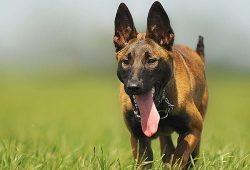The Malinois is a medium-to-large breed of dog, sometimes classified as a variety of the Belgian Shepherd dog rather than as a separate breed. The name “Malinois” is derived from [wiki title=”Mechelen” base=”EN”]Malines[/wiki], the French name for the breed’s city of origin.
The breed is used as a working dog for tasks including detection of odors such as explosives, accelerants (for arson investigation), and narcotics; tracking humans for suspect apprehension in police work; and search and rescue missions. The U.S. Secret Service uses Belgian Malinois to guard the grounds of the White House.
Appearance
The Malinois is a medium-to-large and square-proportioned dog in the sheepdog family. The Malinois has a short mahogany coat with black markings. It has black erect ears and a black muzzle. It has a square build in comparison to the German Shepherd.
Coat and color
Due to its history as a working dog (i.e., being bred for function over form), the Malinois can vary greatly in appearance. The acceptable colors of pure-bred Malinois are a base color fawn to mahogany and tan with a black mask and black ears with some degree of black tipping on the hairs, giving an overlay appearance. The color tends to be lighter with less black agouti or overlay on the dog’s underside, breeching, and inner leg. White markings are also allowed on the tips of the toes and the chest, as long as the white on the chest does not extend up to the neck. A Belgian malinois may have a longer and darker hair coat then the typical malinois but may still be referred to as a malinois.
Size
Males are about 61–66 cm (24–26 in), while females are about 56–61 cm (22–24 in) at the withers. Female Malinois average 20–25 kg (44–55 lb); males are heavier at 25–30 kg (55–66 lb).
Temperament
Well-raised and trained Malinois are usually active, intelligent, friendly, protective, alert and hard-working. Belgian Malinois exhibit energy levels that are among the highest of all dog breeds. A typical Malinois will have puppy-like energy until the age of three, though it is not uncommon for them to exhibit this energy level until the age of five. Many have excessively high prey drive. Some may be excessively exuberant or playful, especially when young.
They can be destructive or develop neurotic behaviors if not provided enough stimulation and exercise. This often causes problems for owners who are unfamiliar with the breed and are not prepared to provide the exercise they require or a job for them to do. They are medium-sized, strong dogs that require consistent obedience training, and enjoy being challenged with new tasks. They are known to be very easy to train, due to their high drive for rewards.
Activities
Malinois can compete in [wiki title=”Dog_agility” base=”EN”]dog agility[/wiki] trials and in [wiki title=”Flyball” base=”EN”]flyball[/wiki], [wiki title=”Herding” base=”EN”]herding[/wiki], obedience, showmanship, and tracking events, and are one of the most popular breeds used in protection sports such as the Schutzhund. In America, herding is a popular activity.
Herding instincts can be measured at noncompetitive herding tests. In 2011 alone, the AKC awarded 39 new herding titles to Belgian Malinois.
Health
The average lifespan of the Belgian Malinois is 10–12 years. Notable health problems prevalent to the Malinois include cataracts, epilepsy, [wiki title=”Thyroid_disease” base=”EN”]thyroid disease[/wiki], [wiki title=”Progressive_retinal_atrophy” base=”EN”]progressive retinal atrophy[/wiki], [wiki title=”Hip_dysplasia_(canine)” base=”EN”]hip dysplasia[/wiki], and [wiki title=”Pannus” base=”EN”]pannus[/wiki], although these problems have been minimized through selective breeding.
Malinois dog. (2017, September 17). In Wikipedia, The Free Encyclopedia. Retrieved from https://en.wikipedia.org/w/index.php?title=Malinois_dog&oldid=801120976


